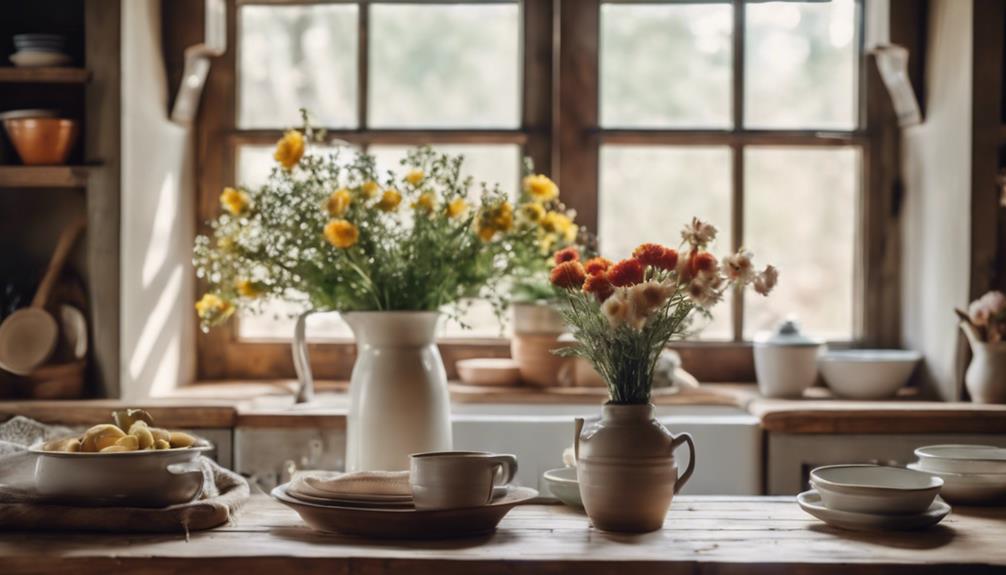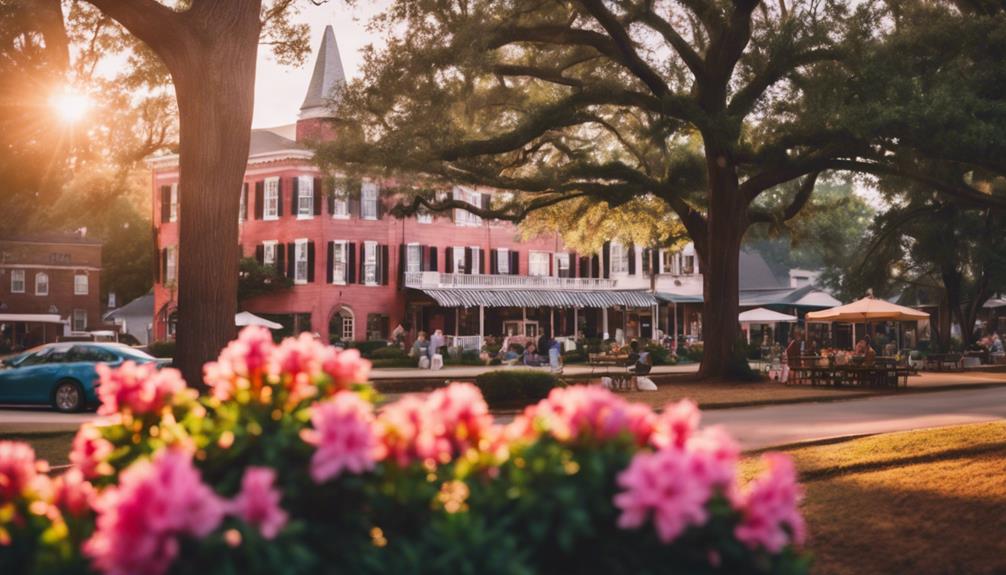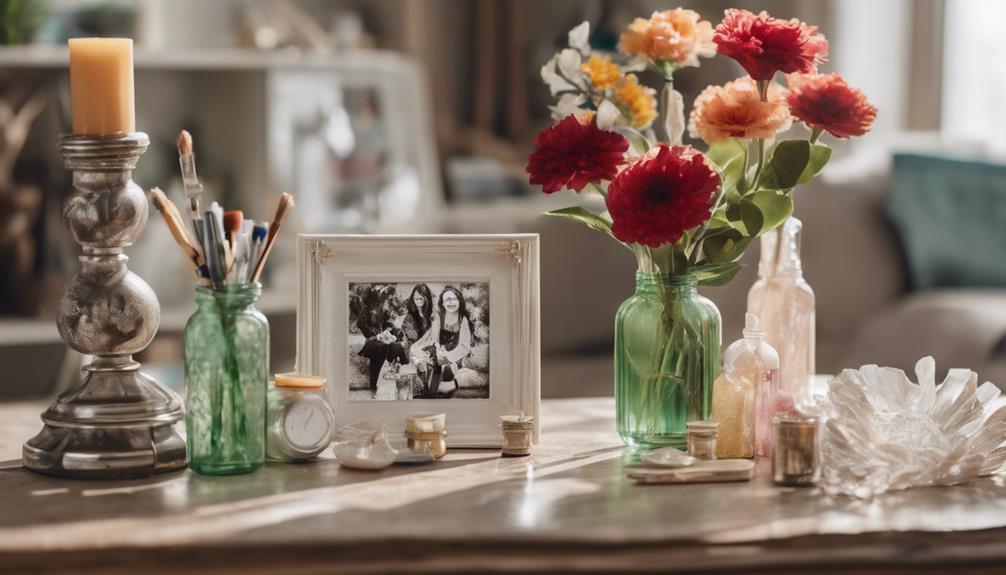Farmhouse kitchen decor captures rustic charm while remaining practical and welcoming. Achieve this aesthetic by incorporating open shelving to showcase your favorite dishes and vintage elements such as antique lighting or reclaimed wood. Stick to a warm color palette with earthy tones, and incorporate textures like woven baskets and jute rugs for a cozy atmosphere. Remember the functionality of deep farmhouse sinks and vintage-style faucets. Personalize your space with well-designed kitchen islands and thoughtful lighting to create a truly inviting environment. Explore different options to elevate your farmhouse kitchen even more.
Key Takeaways
- Emphasize natural materials like reclaimed wood and vintage elements to enhance rustic charm in your farmhouse kitchen decor.
- Utilize open shelving for accessible storage and to create visual interest with personalized displays of dishware and collectibles.
- Incorporate warm, earthy color palettes to establish a calming atmosphere that connects the kitchen to nature.
- Choose deep farmhouse sinks and vintage faucets to combine functionality with classic aesthetic appeal.
Open Shelving Benefits
Open shelving offers you easy access to your favorite dishware and kitchen items, making meal prep more efficient and keeping your space clutter-free. This design choice invites creativity and personalization, allowing you to showcase colorful dishware and cherished decor. You can use open shelving to display your most-loved kitchen items, creating a warm and inviting atmosphere.
By incorporating a layered look with three levels of open shelving, you can add depth and dimension to your kitchen. This approach not only enhances visual interest but also encourages a casual, serve-yourself vibe that's perfect for entertaining. You'll find that mixing open shelving with upper and lower cabinets strikes a balance between functional storage and decorative displays, reflecting your personal style.
As you explore various decorating ideas, open shelving allows you to easily rotate and update your items. Whether it's seasonal decor or evolving collections, you can keep your kitchen looking fresh and inviting. Embrace the benefits of open shelving, and transform your kitchen into a space that's both practical and stylish, making every meal prep a delightful experience.
Maximizing Space Effectively

Finding creative ways to maximize space in your farmhouse kitchen can transform it into a more functional and inviting area. By implementing a few smart strategies, you can enhance both organization and style, all while maintaining that rustic charm you love.
Here are some effective farmhouse kitchen ideas to get you started:
- Repurpose a wood dry sink for extra storage and a touch of character.
- Create DIY plate separators from wooden boxes to display dishware and utilize vertical space.
- Use striped skirt fabric to hide appliances, keeping the kitchen tidy and visually spacious.
- Remove built-in cabinetry to free up usable space, improving functionality without sacrificing aesthetics.
Choosing Rustic Materials

When choosing rustic materials for your farmhouse kitchen, prioritize elements that enhance both charm and functionality, ensuring a warm and inviting atmosphere.
Start with reclaimed wood for your cabinets and shelves; it not only adds character but also promotes sustainability by reusing resources. The unique textures and colors of the wood will create a focal point that draws the eye and sparks conversation.
Next, consider incorporating natural stone for your countertops. Durable options like soapstone or granite complement the rustic design while providing practical surfaces for cooking and entertaining. The organic feel of these materials enhances the overall ambiance of your kitchen.
Don't forget to add vintage elements like antique fixtures or salvaged hardware. These pieces infuse history into your space, making it feel lived-in and unique.
To soften the look, include woven baskets and natural textiles in materials like linen or cotton. They add warmth and texture, balancing the sturdiness of wood and stone.
Color Palettes for Warmth
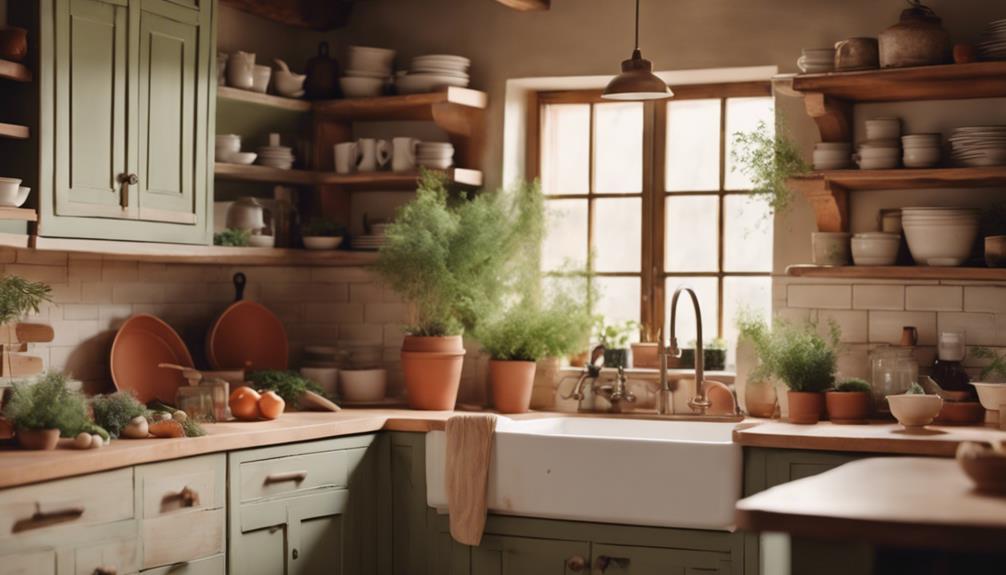
When it comes to creating warmth in your farmhouse kitchen, color plays an essential role.
You can use neutral tones to set a calming foundation, while earthy hues connect your space to nature.
Don't forget to add vibrant accent colors for personality and balance, making your kitchen feel cozy and inviting.
Neutral Tones Emphasize Warmth
Embracing neutral tones like soft whites and light grays instantly creates a calming atmosphere that amplifies the warmth in your farmhouse kitchen.
These neutral colors not only make the space feel more expansive but also enhance the warm and inviting nature that farmhouse style embodies. By layering different shades, you can add depth and visual interest, making your kitchen a cozy retreat.
To effectively incorporate neutral tones in your decor, consider the following ideas:
- Use soft white cabinetry paired with light gray countertops.
- Incorporate earthy greens and browns through accessories like rugs and curtains.
- Opt for matte finishes in your paint and decor to reduce glare and enhance comfort.
- Layer various neutral shades in textiles, such as table linens and seat cushions.
Accent Colors for Vibrancy
Accent colors can breathe life into your farmhouse kitchen, creating a vibrant contrast that enhances the warmth of your neutral palette. By strategically incorporating colors like country blue or soft yellow, you evoke feelings of comfort and nostalgia, perfectly aligning with the rustic farmhouse aesthetic.
Bold hues, such as deep reds or greens, can introduce personality into your space. Consider adding these colors through decor items like barstools, dishware, or wall art. This way, you maintain a balance with earthy tones while still infusing vibrancy.
Layering different shades of accent colors, such as varying greens or blues, adds depth and interest without overwhelming the rustic charm of your kitchen. It's all about finding that perfect balance!
To create a cozy environment, opt for matte finishes on your accent colors. This choice reduces glare and reinforces the inviting feel essential to a rustic farmhouse kitchen.
Fundamentally, the right accent colors not only uplift the aesthetics of your kitchen but also enhance its warmth, making it a welcoming space for family and friends. Embrace these colors to truly transform your farmhouse kitchen!
Earthy Hues Connecting Nature
Earthy hues like beige, brown, and muted greens create a calming atmosphere that brings the beauty of nature right into your farmhouse kitchen. By incorporating these tones, you can establish a serene backdrop that complements your rustic decor. Pairing these colors with natural materials enhances the organic feel of the space, making it inviting and warm.
To achieve the perfect balance, consider these ideas:
- Use wood accents, like open shelving or beams, to add warmth and texture.
- Choose farmhouse sinks in natural stone or matte finishes to maintain a cozy vibe.
- Layer different shades of earthy tones to create depth and visual interest.
- Incorporate accent colors like muted terracotta or soft mustard for a touch of personality.
Incorporating Vintage Elements

Incorporating vintage elements into your farmhouse kitchen adds a layer of charm and character that modern designs often lack. By blending the old with the new, you create a warm, inviting space that tells a story.
Consider using antique pedestal tables or 19th-century English pine dressers as functional decor pieces. Vintage-inspired appliances with retro designs can provide a nostalgic feel while maintaining modern functionality. Reclaimed materials like salvaged wood and vintage tiles also add unique character to your kitchen.
To enhance the rustic vibe, display vintage kitchen tools, signage, and decorative items on open shelving. This not only showcases your style but also keeps your essentials accessible. Don't forget to incorporate vintage lighting fixtures; antique lanterns or Edison bulbs can elevate your kitchen's aesthetics with warm, inviting illumination.
| Vintage Elements | Functionality | Aesthetic Appeal |
|---|---|---|
| Antique Pedestal Table | Provides dining space | Adds historical charm |
| Vintage Appliances | Modern functionality | Nostalgic design |
| Open Shelving | Displays decor & essentials | Enhances rustic vibe |
Embrace these vintage elements to create a farmhouse kitchen that's both beautiful and practical.
Sink and Faucet Styles

When choosing sink and faucet styles for your farmhouse kitchen, think about the practicality and charm of deep farmhouse sinks with an apron-front design.
Pairing these sinks with vintage faucets in materials like aged brass or polished nickel can enhance the nostalgic feel of your space.
Don't forget to take into account the height and reach of the faucet to make certain it meets your cooking needs while maintaining that classic farmhouse look.
Deep Farmhouse Sinks
Deep farmhouse sinks aren't just practical for washing large cookware; they also make a stunning centerpiece in your kitchen design. With their apron-front style and expansive basin depth, they provide both functionality and aesthetic appeal. You'll love how a deep farmhouse sink can elevate your space while accommodating larger dishes and reducing water splashes.
Consider these key features when selecting a sink:
- Material: Fireclay farmhouse sink offers durability and a classic look.
- Size: The depth allows for easy washing of bulky cookware.
- Style: An apron-front design enhances the rustic charm of your kitchen.
- Faucet Compatibility: Pair with vintage-style faucets for a cohesive feel.
These elements will help you create an inviting and functional kitchen. By choosing a deep farmhouse sink, you're not just investing in practicality; you're adding a piece that reflects your style and enhances the cozy, rustic charm of your home.
Vintage Faucet Designs
Vintage faucet designs bring a touch of nostalgia to your farmhouse kitchen, showcasing aged brass or oil-rubbed bronze finishes that enhance both durability and charm. These faucets often feature intricate detailing, like cross handles or porcelain accents, adding to the rustic charm that defines your space.
When you pair a vintage faucet with farmhouse sinks, you create a cohesive look that serves as a stunning focal point in your kitchen. Whether you prefer a bridge, pull-down, or single-handle option, there's a vintage design that fits your kitchen's functionality and style.
Incorporating a vintage faucet elevates the character of your kitchen, making it a unique centerpiece that reflects your personal style and dedication to a rustic design ethos.
The combination of vintage faucet designs and farmhouse sinks not only enhances the aesthetic but also provides a practical solution for daily tasks.
Designing Inviting Kitchen Islands
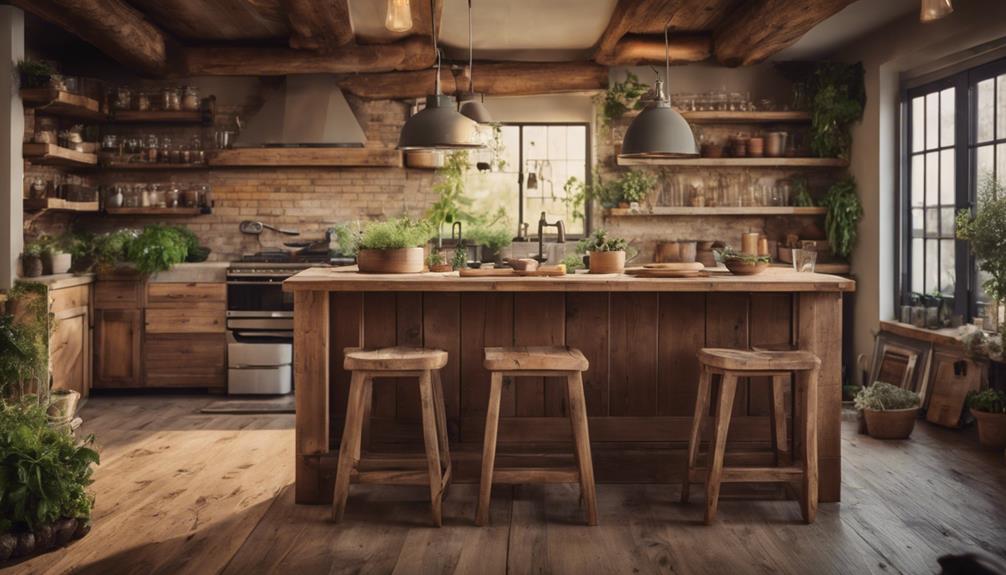
How can you transform your kitchen island into a warm and inviting centerpiece that encourages family interaction and gatherings?
Start by incorporating elements that enhance both functionality and charm. Here are some ideas to help you design a welcoming kitchen island:
- Use reclaimed beams for a rustic touch that adds character and warmth.
- Select a large walnut or natural stone countertop to create a visually appealing workspace that invites cooking and entertaining.
- Incorporate furniture-like details such as decorative legs and drawers to enhance the island's aesthetic while providing storage.
- Add comfortable seating options like handmade counter stools or built-in banquettes, perfect for casual dining or chatting while cooking.
Enhancing Ambiance With Lighting
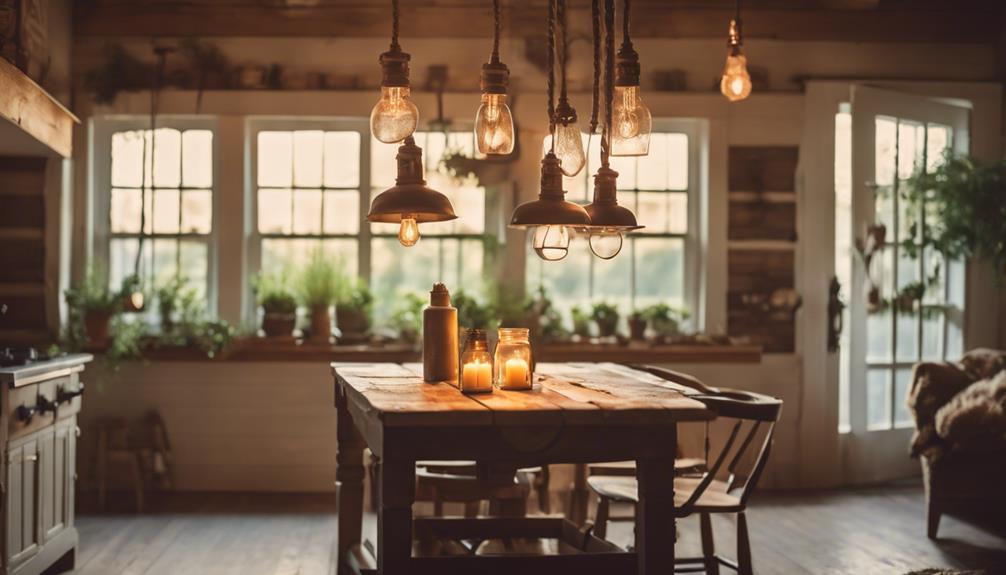
To complement your inviting kitchen island, effective lighting can dramatically enhance the overall ambiance of your farmhouse kitchen.
Start by incorporating battery-operated puck lights under your cabinets. They offer remote control, timers, and dimming options, allowing you to tailor the lighting to suit your mood. For a safe and warm glow, consider using flameless candles, like those from Luminaras. They create an inviting atmosphere without the risk of fire.
Antique French lanterns and vintage-style lighting fixtures can serve as eye-catching focal points, adding character while harmonizing with the rustic elements of your kitchen. To maintain that cozy ambiance throughout the space, combine different light sources. Flush-mount ceiling lights paired with decorative pendant lights work beautifully together.
Don't forget the power of natural light! Maximize it by using light-reflecting tiles and strategically placed windows, enhancing the warmth and inviting feel of your farmhouse kitchen.
Textures and Flooring Options
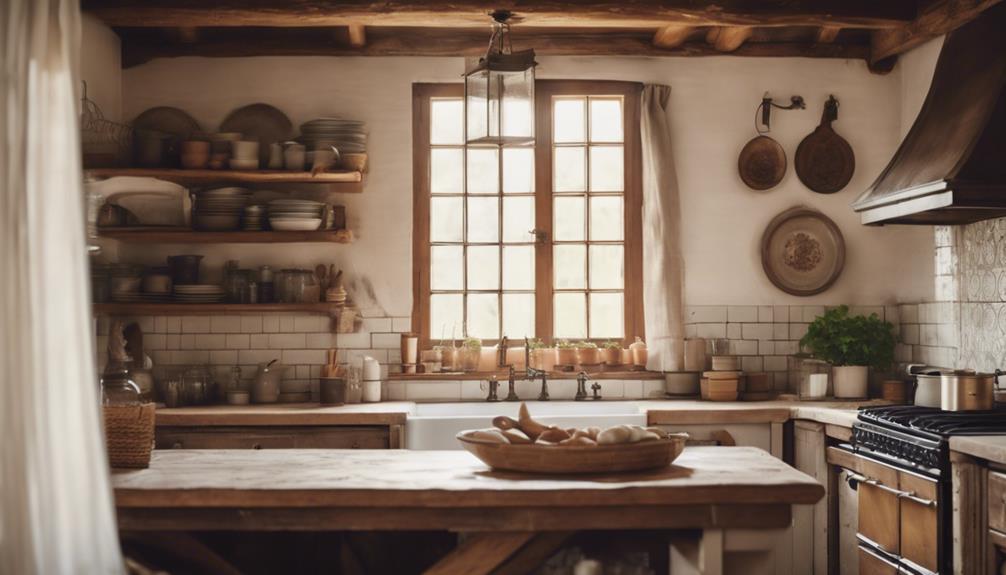
Incorporating natural materials like reclaimed wood and stone can instantly evoke the rustic charm that defines a farmhouse kitchen. By focusing on textures and flooring options, you'll create a warm and inviting atmosphere that's both functional and stylish.
Consider these five options to enhance your kitchen's aesthetic:
- Reclaimed Wood: Use for flooring or accents to add warmth and character.
- Moroccan Floor Tile: Opt for aged finishes that introduce soft colors and durability.
- Painted Checkerboard Floors: Make a bold statement that brings visual interest to your space.
- Jute Rugs: Add comfort underfoot while providing an organic touch that complements your decor.
Frequently Asked Questions
Can You Mix Rustic and Farmhouse?
Yes, you can mix rustic and farmhouse styles! Combine elements like reclaimed wood and shaker cabinets, use earthy colors with soft whites, and add personal touches to create a warm, inviting atmosphere that feels uniquely yours.
What Is the Difference Between Rustic and Farmhouse Decor?
The difference between rustic and farmhouse decor lies in their aesthetics. Rustic focuses on raw, natural materials and simplicity, while farmhouse blends those elements with polished finishes and a lighter, more inviting color palette.
How to Create a Rustic Farmhouse Kitchen?
To create a rustic farmhouse kitchen, incorporate reclaimed wood, open shelving, and a deep farmhouse sink. Use earthy tones, vintage fixtures, and personal touches to enhance warmth and charm while ensuring functionality meets your needs.
How Do I Make My Kitchen Look Rustic?
To make your kitchen look rustic, incorporate natural materials like reclaimed wood and stone. Use open shelving for display, choose earthy tones, add vintage fixtures, and include rustic appliances to create a warm, inviting atmosphere.
What are the similarities between farmhouse kitchen decor and farmhouse Christmas decor?
Both farmhouse kitchen decor and festive farmhouse Christmas decor embrace rustic elements like natural wood, vintage accents, and simple yet cozy aesthetics. The common use of earthy tones, handcrafted items, and charming details make these two styles seamlessly blend together, creating a warm and inviting atmosphere.
Conclusion
Incorporating farmhouse kitchen decor can transform your space into a rustic haven.
Did you know that 70% of homebuyers consider the kitchen the heart of the home?
By embracing open shelving, warm color palettes, and vintage elements, you'll create an inviting atmosphere that draws family and friends together.
Don't forget to enhance your kitchen with the right lighting and textures to truly elevate the experience.
Your dream farmhouse kitchen is just a few thoughtful choices away!
